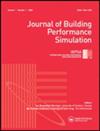基于轻量级数据驱动模型的厂房暖通空调系统实时预测控制
IF 2.3
4区 工程技术
Q2 CONSTRUCTION & BUILDING TECHNOLOGY
引用次数: 2
摘要
本文提出了一种模型预测控制(MPC)在某冰淇淋厂暖通空调系统中的实时实现方法。目标建筑由两个大型开放空间组成,由两个HVAC系统提供服务。我们建立了四个人工神经网络(ANN)模型来预测两个热区送风和室内空气的热状态,并证明了足够的准确性(MBE = 2.65, CVRMSE = 9.43)。本研究采用的控制变量为冷水机组运行数量、送风风机变频频率和室外进风比。目标函数最小化总能源使用,并设置约束以保持室内平均空气温度接近设定点。从2021年8月3日至8月30日,实时MPC在20分钟的采样时间内实现,与现有的简单的基于规则的控制相比,可以节省约31.7%的电力。本文章由计算机程序翻译,如有差异,请以英文原文为准。
Real-time predictive control of HVAC systems for factory building using lightweight data-driven model
This paper presents a real-time implementation of model predictive control (MPC) for HVAC systems in an ice-cream factory building. The target building consists of two large open spaces served by two HVAC systems. We developed four artificial neural network (ANN) models that predict the thermal states of the supply air and indoor air of the two thermal zones and prove to be accurate enough (MBE = 2.65, CVRMSE = 9.43). The control variables employed in this study are the number of operating chillers, frequency of supply-air fan inverter and outdoor-air intake ratio. The objective function minimizes total energy use, and a constraint was set to maintain average indoor air temperatures close to set points. Real-time MPC was implemented at a sampling time of 20 min from 3 August to 30 August 2021 and could save approximately 31.7% of electricity when compared to the existing simple rule-based control.
求助全文
通过发布文献求助,成功后即可免费获取论文全文。
去求助
来源期刊

Journal of Building Performance Simulation
CONSTRUCTION & BUILDING TECHNOLOGY-
CiteScore
5.50
自引率
12.00%
发文量
55
审稿时长
12 months
期刊介绍:
The Journal of Building Performance Simulation (JBPS) aims to make a substantial and lasting contribution to the international building community by supporting our authors and the high-quality, original research they submit. The journal also offers a forum for original review papers and researched case studies
We welcome building performance simulation contributions that explore the following topics related to buildings and communities:
-Theoretical aspects related to modelling and simulating the physical processes (thermal, air flow, moisture, lighting, acoustics).
-Theoretical aspects related to modelling and simulating conventional and innovative energy conversion, storage, distribution, and control systems.
-Theoretical aspects related to occupants, weather data, and other boundary conditions.
-Methods and algorithms for optimizing the performance of buildings and communities and the systems which service them, including interaction with the electrical grid.
-Uncertainty, sensitivity analysis, and calibration.
-Methods and algorithms for validating models and for verifying solution methods and tools.
-Development and validation of controls-oriented models that are appropriate for model predictive control and/or automated fault detection and diagnostics.
-Techniques for educating and training tool users.
-Software development techniques and interoperability issues with direct applicability to building performance simulation.
-Case studies involving the application of building performance simulation for any stage of the design, construction, commissioning, operation, or management of buildings and the systems which service them are welcomed if they include validation or aspects that make a novel contribution to the knowledge base.
 求助内容:
求助内容: 应助结果提醒方式:
应助结果提醒方式:


